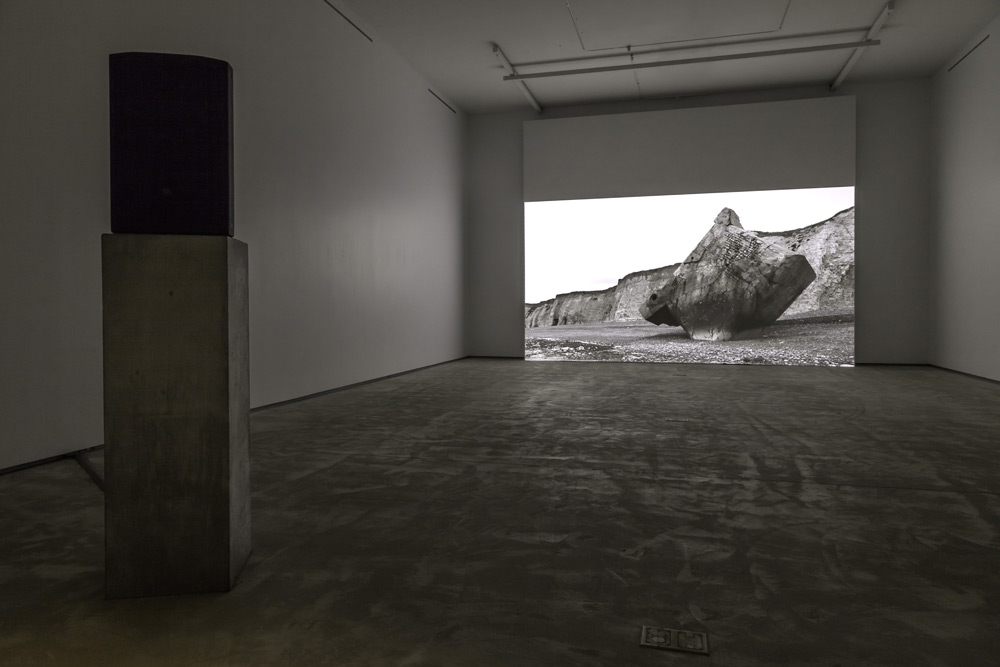Among the architectural relics in Kingston, Ontario, are Fort Henry and Kingston Penitentiary. Designed as instruments of control—over populations inside and economic and territorial interests outside fragile borders—they now stand as monuments to the emerging state’s military and surveillance activity. It is this terrain—of military architecture, technologies and intelligence—that artist, writer and curator Charles Stankievech has inhabited for the last several years, making his current exhibition in that city a good fit.
“Monument as Ruin” completes a trilogy of exhibitions that explores 20th-century military-outpost technologies, and theorizes three paradigms of early warning systems. “The Dew Project” (2009) and “The Soniferous Æther” (2013) engaged with the last stage, electromagnetic communication networks and their corresponding architecture of distributed geodesic domes in Arctic outposts. This current exhibition considers two earlier stages: post-First World War sonic intelligence-gathering devices and German bunker, or casement, technology deployed during the Second World War.
As outlined by Stankievech, the sonic stage is represented by paraboloid sound mirrors, created in Britain in response to the new threat of aerial warfare. These giant, concave structures, built on cliffs facing the English Channel, were designed to detect and amplify sounds from advancing warplanes.
A second stage is represented by the Second World War German bunkers that, in their cemented solidity, still loom large along the northern-European Atlantic Coast. The technology employed a visual modality, as enemy engagement was dependent on sight. Unlike contemporary microelectronics with their dispersed focus, these sound mirrors and bunkers share a centralized focus: the paraboloid’s sound detection occurs at its centre and the poured concrete bunker has its own centre of gravity and structural integrity, independent of the earth beneath it.
Stankievech uses the term “fieldwork” to describe his practice: engaging with a geographic site or “embedded landscape,” he merges architecture, installation, site-specific earthwork and such communication “fields” as sonic and electromagnetic. The effect of this approach here, as combined with interdisciplinary research and media, is kaleidoscopic.
The two exhibition rooms offer different experiences. The first gathers artwork and artifacts that playfully posit the exhibition themes. Stankievech’s own works include two large photographs, each framing an Atlantic Coast military ruin. One, Monument as Ruin (Earth) (2011), is a paraboloid, and the other, Monument as Ruin (Wreck) (2011), is a massive bunker that, fallen from a cliff, stands monolithically on its end. To powerful effect, the images are aestheticized through dark tones and brooding skies. The surrounding brush, softened by breeze and long exposures, suggests tension between the durability of war across transient time. Only in their typological value are these images aligned with Bernd and Hilla Becher’s documents of outmoded industrial structures. Three dark grey sculptures by Stankievech—scaled-down cast concrete replicas of bunkers—occupy the floor space like lounging Henry Moore figures.
Remaining objects testify to Stankievech’s curatorial drive and his interest in the “fragment” as a form for knowledge production, and invite rumination on ruins and monuments, war and power. Three black meteorites seem as tiny versions of the bunker sculptures, both appearing as sentient signals from across time and space. In Giovanni Battista Piranesi’s etching, Hadrian’s Villa: The Apse of the So-Called Hall of the Philosophers (1774), several figures stand dwarfed beneath crumbling Roman ruins. Textual artifacts include a 1939 science fiction novella by A.E. van Vogt that figures anxiety about alien invasion; a computer card alludes to IBM’s contribution to the Nazis’ Final Solution, in its provision of data-processing technology capable of rationalizing massive numbers of human bodies. Also significant is a catalogue from Science Fiction, an exhibition curated by Harald Szeemann that was instrumental in shifting curatorial practices toward a style that the artist himself here practices.
Stankievech designed a self-reflexive broadsheet for this exhibition, which belies its debt to Szeemann’s radical curatorial process through such details as its silver and black ink. Stacked on a cement pedestal inside the gallery alongside the other works, it is itself an art object integral to the exhibition.
Inside this newsprint spread (a paper stock chosen for its ability to quickly become ruin) two essays bookend 13,000 words of quotations from sources as diverse as Friedrich Schlegel, Carl von Clausewitz, Virginia Woolf and Robert Smithson. Visitors, taking the dense theoretical and historical commentary away from the gallery, effectively extend their exhibition experience.
An immersive installation, The Second Coming (2015), occupies the second room. Facing each other across an expansive grey cement floor are a large projection screen and a cement scale sculpture of a sound mirror. A speaker standing on a cement plinth is directed toward the paraboloid. A 19-minute looped video screens long shots of bunkers in their seashore environments. Colin Stetson’s experimental saxophone sounds reverberate from the concave acoustic, pounding deep within listening bodies. The grey tones of the dimmed smooth space merge with Atlantic seashore, the persistence of war through time, the sax warning a trumpet wail and, finally, a long shot of falling light lingering over dark sea, slipping suddenly into darkness—all impress a sense of gravitas. If the fragments in the first room circle playfully around these troubled themes, the affective punch in the second room drives the sombre message home. These dark monuments are our ruin.
Though these remnants of earlier military technology narrate a deadly, foreboding past, they seem almost quaint to us now—as listening algorithms capture all our keyboard clicks and military drones do their silent and invisible killing from the military game rooms in the Nevada desert. Surveillance studies scholar David Murakami Wood, in his exhibition-related talk, noted that what the public learns through occasional leakage, through the Snowdens and the Assanges, is but a “tiny window of what happens” in the sublime realms of deep state surveillance.









